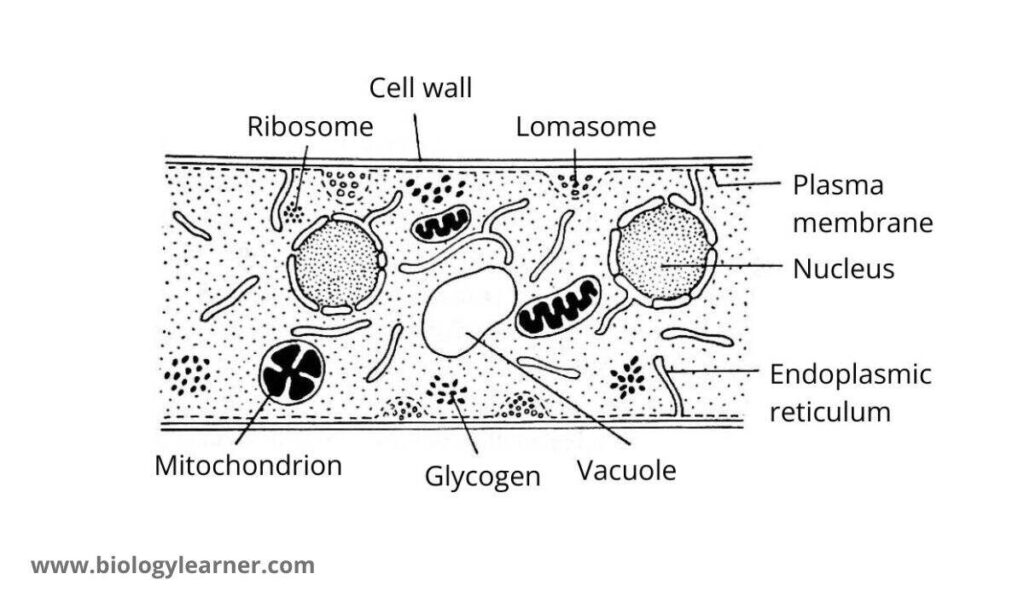Fungi are eukaryotic, spore-bearing microorganisms. They are heterotrophic (i.e., can’t produce their own food through photosynthesis) and digest food externally by releasing hydrolytic enzymes into their surroundings.
Fungi have unicellular or multicellular organization, but the structure of cells is uniformly the same in all organizations. The cells are eukaryotic and consist of all the cell organelles, like the cell wall, Golgi complex, mitochondria, endoplasmic reticulum, and nucleus. But fungi are non-green plants and lack chloroplasts in their cells.

The detailed cell structure of fungi is as follows:
Cell Wall
The fungal cell is surrounded by a rigid cell wall, which is made up of 2–7 layers.The composition of the cell wall varies among different groups of fungi.
In most fungi, the cell wall lacks cellulose but contains a form of chitin known as fungal cellulose. The chitin is present as elongated, variously oriented microfibrillar filaments. These microfibrillar filaments are arranged in the form of layers and run parallel to the surface. Many non-fibrill materials are also associated with the microfibrillar components.
In some lower fungi (Oomycetes), cellulose and glycan are found. In Peronospora and Saprolegnia, true cellulose is present, while in Pythium and Phytophthora, glucan predominates in their walls.
Cellulose and chitin have been reported to occur together in the cell walls of a few species.
Plasma Membrane
Below the cell wall, a thin plasma membrane is present. It is semipermeable and regulates the movement of soluble materials.
The plasma membrane invaginates at the surface, in the region where the fusion of secretory vesicles of the cytoplasm occurs, and forms pouch-like structures enclosing the granular or vesicular materials. These structures are called lomasomes (Moore and McLear, 1961).

Cytoplasm
Within the plasma membrane is the colorless cytoplasm, in which sap-filled vacuoles are found.
The cytoplasm contains many cell organelles, such as mitochondria, ribosomes, dictyosomes (Golgi apparatus), endoplasmic reticulum, and vacuoles.
Mitochondria
Many small, spherical mitochondria are present in the cytoplasm. Each mitochondrion is covered by a double membrane. The inner membrane is infolded to form parallel, flat plates or irregular tubules known as cristae.
In growing hyphae, which are more active, fungal mitochondria are less flat and smaller as compared to green plants.
Endoplasmic Reticulum
The endoplasmic reticulum (ER) in fungal cells is usually vesicular. It is more irregular than those in the cells of green plants.
However, the ER in fungal cytoplasm can only be seen under an electron microscope.
Dictysomes (Golgi Apparatus)
Dictyosomes, or Golgi apparatus, very rarely occur in fungal cells (except in Oomycetes). These are made up of small and round vesicles.
In Yeast cells, the dictyosome consists of three flattened sacs.
Ribosomes
The ribosomes found in the cytoplasm are of the 80s type. These are small membraneless ribonucleoprotein particles. The structure is the same as that of green plants.
Vacuoles
Vacuoles are found near the cell wall and are mainly seen in the old cells. Each vacuole is surrounded by a membrane called the tonoplast.
Vacuoles may contain pigments and crystalline, amorphous materials.

Nucleus
There are one, two, or more nuclei in the cytoplasm.
The fungal nucleus is small, globose, or spherical, having a diameter of about 2–3 micron. It consists of a bilayered nuclear membrane that encloses the chromosomes and nucleolus.
The nuclear membrane is attached to the ER, which is expanded in the cytoplasm.
Reserve Food Materials
The main food reserve is glycogen. Along with it, the alcohol mannitol is found in some fungi. Sometimes lipids and proteins are also present as storage products.
